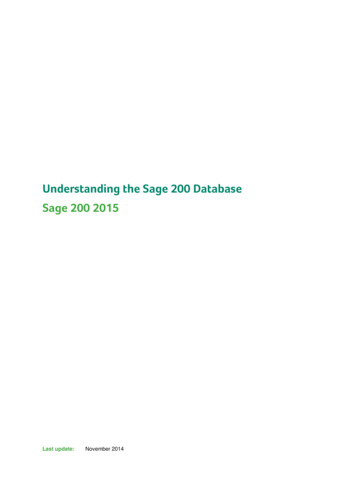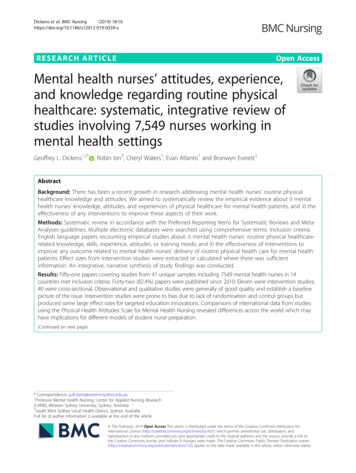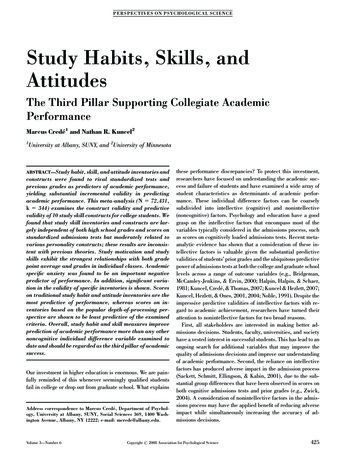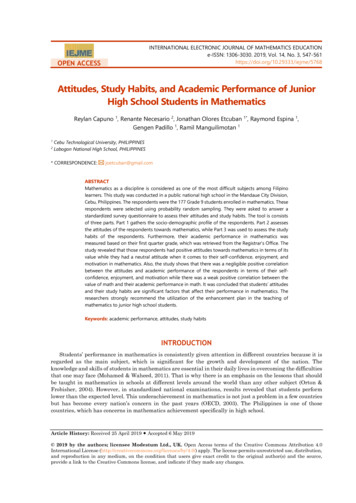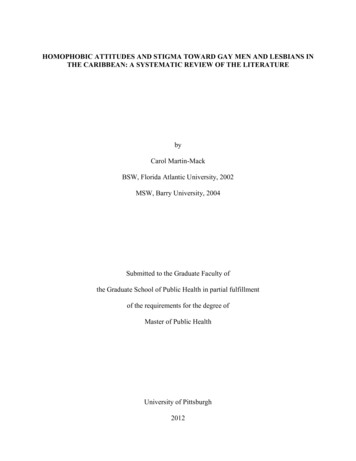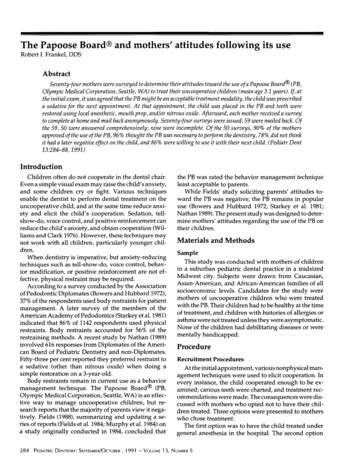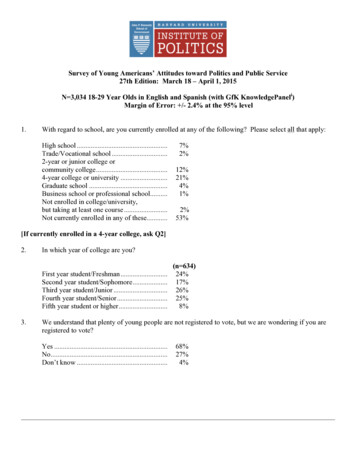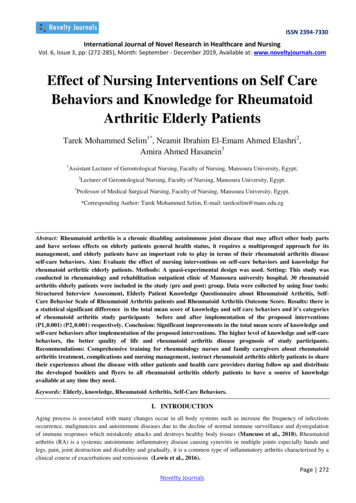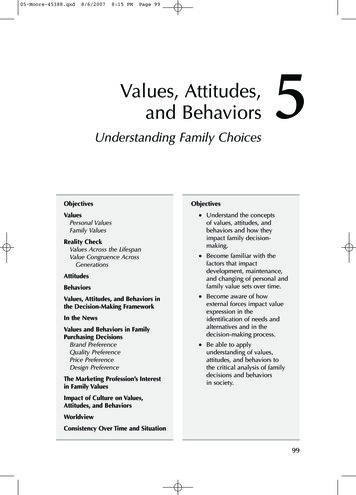
Transcription
05-Moore-45388.qxd8/6/20078:15 PMPage 99Values, Attitudes,and BehaviorsUnderstanding Family ChoicesObjectivesValuesPersonal ValuesFamily ValuesReality CheckValues Across the LifespanValue Congruence AcrossGenerationsAttitudesBehaviorsValues, Attitudes, and Behaviors inthe Decision-Making FrameworkIn the NewsValues and Behaviors in FamilyPurchasing DecisionsBrand PreferenceQuality PreferencePrice PreferenceDesign PreferenceThe Marketing Profession’s Interestin Family Values5Objectives Understand the conceptsof values, attitudes, andbehaviors and how theyimpact family decisionmaking. Become familiar with thefactors that impactdevelopment, maintenance,and changing of personal andfamily value sets over time. Become aware of howexternal forces impact valueexpression in theidentification of needs andalternatives and in thedecision-making process. Be able to applyunderstanding of values,attitudes, and behaviors tothe critical analysis of familydecisions and behaviorsin society.Impact of Culture on Values,Attitudes, and BehaviorsWorldviewConsistency Over Time and Situation99
05-Moore-45388.qxd8/6/20071008:15 PMPage 100DISCOVERING FAMILY NEEDSNot everything that can be counted counts, and not everythingthat counts can be counted.—Albert EinsteinIndividuals and families discover, rank, and create evaluative meaningsfor their needs. Every step of the decision-making process is impactedby one’s values, attitudes, and behaviors. When family members are contemplating or discovering needs, they rely on these subjective measures torank order or prioritize the multiple needs. For instance, family membersneed clothing. When that new clothing is required is a function of existingresources and environmental conditions. Beyond that, in American society, new clothing purchases are motivated primarily by social expectationsand how deeply the family unit is persuaded to follow fashion and socialpressure. A bride needs a wedding dress, right? Well, actually, legal marriage ceremonies do not mandate participants’ dress. If a traditional wedding dress is perceived as a real need, it is processed as such. From thatpoint, values and resources are weighed to determine what type of dress isobtained and how it is secured. Will it be borrowed? Purchased? Created?To understand the impact of values, attitudes, and behaviors on familyresource management, we must understand the definitions of many termsthat are often used loosely.ValuesValue is a term used often in the discussion of human behavior from twounique perspectives. When discussing economics and consumer behavior,the term value is used as a measurement of exchange. If you spend moneyon goods or services, you expect satisfaction from that exchange of resources.It is determined to be a good value if the person exchanging resources feelsthat he or she received a fair return. This determination of fairness is subjective. A baseball card collector may feel that one single card is worth several hundred dollars. Someone who is not involved in this hobby may feelthat such a purchase would be a waste of monetary resources. A grandmother’s collection of photographs may be priceless to one grandchild, butof little perceived value to another.Another common use of the term value is perhaps even more subjectiveand personal in nature. Guiding principles of thought and behavior areoften referred to as one’s values. It is believed that these principles developslowly over time as part of the individual’s social and psychological development. Researchers have focused on these dispositions in numerous scientific studies in an attempt to measure, predict, and understand howvalues guide thought and action.
05-Moore-45388.qxd8/6/20078:15 PMPage 101Values, Attitudes, and Behaviors101A search for universal values has been troublesome to theorists. Humanrights are discussed and presented as universal values, yet some of theserights are not embraced by all groups. The practice of female genital mutilation, or female circumcision, is one such debated violation of humanrights. Boulding (1985), an economist and philosopher, purports thathuman betterment is an appropriate goal for everyone across all culturesand nations. Human betterment, or an increase in the quality of life for all,is reflected in four dimensions: economic adequacy, justice, freedom, andpeacefulness.Universal values may be difficult to define, but cultural or social valuesare not. When a group of people embrace a set of understood values,members operate within those beliefs and are judged accordingly. The discussion of worldview in chapter 1 illustrates this concept.In the United States, especially in business and educational institutions,punctuality is highly valued. Teachers expect students to be in class whenthat class is scheduled to begin. Not every American accepts that one particular value, but being late is generally unacceptable and carries consequences. Being late for a commercial airplane flight may result in the lossof the price of that ticket and the loss of travel via that medium. Being latefor a meeting may result in missed leadership opportunities or, in somecases, unwanted responsibilities.PERSONAL VALUESValues, when framed within a religious or spiritual framework, areoften referred to as morals. Using morals in decision-making is placingvalue judgments on a continuum of right and wrong. Kohlberg (1984)proposes that humans develop a set of morals as they mature, bothsocially and intellectually (see Table 5.1). One’s sense of justice and how heor she makes judgments about what are good and bad decisions evolveover time primarily due to changes in cognitive abilities. Young, schoolage children think concretely. Something is always right or always wrong,Table 5.1Kohlberg's Sequence of Moral ReasoningLevelStagePre-conventional1. Obedience and punishment2. Individualism, instrumentalism, and exchangeConventional3. “Good boy/girl”4. Law and orderPost-conventional5. Social contract6. Principled conscience
05-Moore-45388.qxd1028/6/20078:15 PMPage 102DISCOVERING FAMILY NEEDSthere are no shades of gray. Adolescents, who are capable of abstract thinking, will begin to contemplate each situation in terms of context, alternatives, and impact of actions on self and others. Some adults, according toKohlberg’s sequence, will consider universal moral principles even at therisk of breaking their own civil laws. One example frequently used toexplain this concept is the husband who would break into a pharmacy tosteal a medication that would keep his wife alive, rather than let her diebecause he couldn’t pay for it.Although this model of moral development assumes a progressionthrough stages, it does not assume that every individual moves througheach and every stage. Thus, any group of adults may have individuals functioning at different phases of Kohlberg’s model. Obviously, a multigenerational family will also have members operating at different levels. Adults infamily units are most often the final decision makers, but that does notmean that family decisions will then reflect the higher moral levels. If thoseadults are functioning at lower levels, decisions will reflect that.Mr. and Mrs. Jones set aside an entire day each February to preparetheir income tax returns. They read the directions carefully and reportboth their earnings and deductions honestly. Mr. and Mrs. Smith waituntil the last day to file taxes. They claim only the income they havereceived that can be traced through federal reporting forms and exaggerate many deduction amounts to reduce their final tax payment. TheJones’ are functioning at a moral level that reflects their beliefs in whatis right and what is wrong and their sense of obligation to the government. The Smiths may feel that the government is misusing funds collected through taxation or may rationalize their behavior in other ways.Moral beliefs that are held strongly enough within a group may ultimatelybecome laws with punitive legal consequences. Accurate reporting of information on tax reports has legal consequences, but only when discovered.When faced with decisions that impact society, but aren’t mandated bylaw, family members responsible for making decisions regarding resourcemanagement must rely on their values, morals, and past experiences toreach decisions that they are comfortable making. One purchase decisionfaced by many families is the procurement of a vehicle for transportation.This decision has personal, family, and social ramifications.When contemplating the purchase of automobiles in the United States,consumers have many options. The selection includes many sizes, configurations, materials, and fuel sources. Some vehicles are fuel-efficient,whereas others are gas-guzzlers. Current laws do not impose restrictionson gas mileage of automobiles. A conscientious consumer may forgo somesize capacity and styling options because he or she wants to reduce thepollution and consumption of gasoline. Another may be determined to
05-Moore-45388.qxd8/6/20078:15 PMPage 103Values, Attitudes, and Behaviors103buy larger, less efficient vehicles because he or she needs the size to transport others and/or materials. Neither is breaking a law. Both are expressing their consumer rights. Both may value the need to reduce air pollutionand fossil fuel consumption. The second owner, however, is rationalizinghis or her purchase by prioritizing existing needs (hauling capacity) aboveenvironmental concerns.FAMILY VALUESReality CheckJeremiah was born and raised in a conservative, Catholic community inthe Midwest. He was the oldest of five children in a family that struggledto stay at the poverty line. He is approaching retirement age and reflectson the choices he has made over his adult life that were directly relatedto his inability to operate within the values and attitudes of his hometown.At 22, I hitchhiked across four states to the East Coast. I hadcompleted a college degree in journalism, but knew that Iwouldn’t be happy in the geographical area I had grown up infor many reasons. One major reason—I was gay. In the sexualrevolution of the 1960s, that wasn’t such a radical thing, but inmy home community, it was unacceptable. I went to Woodstockand hung out in New York City for a while and really enjoyedthe lifestyle there. I met my life partner shortly after arriving.Eventually we moved to a small coastal community betweenNew York and Washington, DC.Jeremiah physically separated himself from a value set that haddiscounted him and his sexual orientation, which resulted in a physical and emotional separation from his family of origin.My younger sister knew why I had moved away. My parents andextended family probably knew, but never acknowledged that,even now, 40 years later. I sent cards and letters home occasionally. My siblings, and even my mother, made short visits toVirginia and spent time with me, in my home, where my partnerwas also living. He was always referred to as my friend and roommate by family members. I was always up-front about our jointownership of property and our growing investment portfolio.Eventually, I think they saw him as a “business partner” of sorts.(Continued)
05-Moore-45388.qxd8/6/20078:15 PM104Page 104DISCOVERING FAMILY NEEDS(Continued)I missed some important family gatherings, but always traveled back for anniversaries and weddings. Holidays were usuallyspent with my partner and our large extended family of friendsand neighbors in our neighborhood. As I get older, I visit homemore often. My partner has never gone back to the Midwestwith me. It wouldn’t be comfortable for him. Recently, his fatherdied, and I was included in the obituary as his “life partner.” Thatwas a very emotional event for me. He was not acknowledgedin that way in my parents’ obituaries. But I do think my siblingsand their families would be okay with it now. They address cardsto both of us now and include my partner in invitations.Values, attitudes, and behaviors are slow to change. Jeremiah’s familyjourney spanned almost half of a century.Because families consist of more than one individual, the probabilitythat family members’ values will clash with one another on occasion isquite high. To understand how values impact the decision-making processof families, group dynamics must be explored. Do families develop uniquevalue systems over time that might differentiate one family from another?Homogamy is a term used to describe the purposeful selection of matesfrom a pool that has similar characteristics to our own. Homogamy ismost visible in terms of race, religion, and social class. Although manycontemporary thinkers may claim that this practice is fading, what do statistics indicate? Kalmijn (1998) reports that marriages are largely homogamous, in both the United States and around the world.Although laws forbidding interracial marriages are no longer legal orenforceable, according to 1994 data, less than 1% of Whites married nonWhites (Starbuck, 2006). This rate is much lower than would be expected ifmates were selected without regard to race. The number of interracial couples has increased in the United States since 1960. However, they remaina small percentage of all marriages. By the 1990s, attitudes toward interracial marriage remained unfavorable. Survey results indicated that 66% ofWhites still opposed the marriage of a close relative to an African American,and 45% opposed a relative’s marriage to an Asian or Latino (Wilkerson,1991). A more recent survey of college students by Bonilla-Silva and Forman(2000) found that only 30% approved of marriages between Whites andAfrican Americans. Johnson and Jacobsen (2005) suggest that for Whites,educational and religious institutions provide social arenas for positiveattitudes about interracial marriage, whereas work sites and neighborhoodcontacts do not.
05-Moore-45388.qxd8/6/20078:15 PMPage 105Values, Attitudes, and BehaviorsIn North America, between 80 and 90% of Protestants are married toProtestants. The marital homogamous rate among Jews is 90% and Catholicsbetween 64 and 85% (Eshleman, 1994). These figures imply a purposefulsearch for a partner with similar religious morals and values. Educationallevels may be even more important in mate selection than religious affiliation. Blackwell and Lichter (2000) reported that married and cohabiting couples are highly homogamous with respect to education. Another possiblyconfounding variable is the strong interrelationship between religion andrace. American Mormons are overwhelmingly White, and African Americansare predominantly Protestant. Determining which factor—race or religion—guides mate selection becomes problematic.Homogamy, in terms of social class affiliation, has been a factor in mateselection in all known societies. Although there is probably more mixedclass marriage in the United States than in many other countries, intraclasspairings are the norm. A pattern of finding mates whose parents have similar occupations to one’s own parents is also firmly entrenched in U.S.courtship and marriage. Even geographical location impacts this type ofhomogamy. Neighborhoods are often delineated by income level and socialclass. Although transportation and career mobility have changed the opportunities for mate selection across geographical distances, most couples stillfind each other in relatively narrow geographical areas—community orstate of origin.Peggy was born and raised in an affluent suburb of Washington, DC. Herfamily was White, upper middle class, and Catholic. She attended private religious schools from K-12 and then attended an Ivy League college. Rarely was Peggy in a social situation where there were children oradults from minority groups. Her pool of dating partners reflected littlediversity.Jolie grew up in Harlem, New York City. Her mother was AfricanAmerican, and her father was of Cuban descent. Her neighborhood,schools, and church were culturally and racially mixed, with the exception of Whites. Few White children attended her schools, and even fewerparticipated in her religious and social activities. Although her poolof dating partners was more diverse than Peggy’s, it still reflects a segregated sample.Odds are that both of these females will select mates that are similarto them in terms of socioeconomic class and race. This is not necessarilypurposeful homogamy, but more likely experiential in nature. Whendiverse families live and interact together, the rate of interracial relationships should be higher. Statistics in such cases, however, still indicate thatpurposeful selection of mates is impacted by race and ethnic preferences.According to the data and theory on homogamy, it appears that couplesforming new households and family units bring similar backgrounds with105
05-Moore-45388.qxd1068/6/20078:15 PMPage 106DISCOVERING FAMILY NEEDSthem in terms of race, religion, and social class factors, which would suggest that they have similar value and moral bases. Although probably truein the majority of cases, it is still essential that compromise and negotiation take place initially in newly formed families, thus resulting in aunique blending of values and approaches to decision-making. These setsof family values will guide family resource management over time. Aswith all social memberships, family members may deviate from established family values, but there will be consequences for them in doing so.Patrick and Katria are both college students in the central region of theUnited States. Although they have both grown to adulthood in different states, their educational, religious, and social experiences havebeen quite similar. When they decide to marry, there are minor differences between the families in terms of wedding details and livingarrangements, but nothing extremely out of the ordinary.Derrick and Charlene are both Hispanic. Derrick has been raisedin the Midwest in a foster home with a Euro-American family andmiddle-class social and educational experiences. He moved to theSouthwest for employment and met Charlene. Charlene has grownup in a border town with language and economic challenges.Although, by all outward appearances, the marriage of these twoyoung people would appear homogamous, they have many moreobstacles and much more intense negotiation to work through as anew family unit.Changing immigration patterns in recent decades have had a majorinfluence on family and household behaviors in the United States (Taylor,2002). As previously presented in chapter 1, worldviews shape the valuesand behaviors of newly immigrated families and individuals. Over time,these families may assimilate to the value system of the majority, or theymay create a unique blending of the two. Since early in the 1900s, thelargest wave of immigrants has been from Latin America, Asia, and otherThird World countries. Although studies have varied greatly in reportingstructural differences in the family unit that are culturally derived, it isimportant to remember that the family unit is essential within all minority communities. Differences among these groups in family practices andliving arrangements are the result of “unique demographic and ancestralbackgrounds, cultural histories, ecological processes, and economic origins and statuses” (Wilkinson, 1987, p. 204).Food consumption choices are deeply embedded in values—personaland cultural. Choosing to be a vegetarian is a conscious decision of manyAmericans. This choice is often in opposition to that of other family members. The main reasons for choosing a vegetarian diet today are health,animal ethics, and environmental issues (Bryant, De Walt, Courtney, &Schwartz, 2003). All of these reasons reflect certain values held by individuals and their social groups.
05-Moore-45388.qxd8/6/20078:15 PMPage 107Values, Attitudes, and BehaviorsPhoto 5.1Thanksgiving meals reflect family values on many levels.Source: Larry Williams/CorbisWhen one or more family members practice vegetarianism and otherfamily members do not, meal planning, food procurement, and foodpreparation increase in complexity. Restrictive diets of any kind requireadvance planning and continual monitoring. Thus, family resources—time, effort, and economic—must be expended to enable family membersto follow specific dietary regimes.Religious commitments often impact food selection and consumptionin the United States and across the globe. Hinduism promotes a strong tradition of vegetarianism rooted in more than 2,000 years of history (Bryantet al., 2003). Vegetarianism is widespread in Buddhism and Jainism, whichpromote nonviolent treatment of all beings and so prohibit the killing ofanimals for consumption (Whorton, 2000). Hunger fasts and product boycotting are also expressions of values held by individuals and social groups.Economic values are also expressed in food consumption. When families purchase food in bulk, stockpile, or devote time and energy to thegrowing of raw foodstuffs, they are expressing their values or beliefs aboutmaterialism and the efficient use of family resources. When familiesdepend on fast food and restaurant catering to meet their food needs, theyare expressing their values of time and financial expenditures. Purposefullyselecting foods and planning meals to meet nutritional requirements is alsoan expression of values—health, longevity, and self-discipline.The phrase family values also has been used to discuss socioeconomicconcepts pertaining to the family as a social institution. Folbre (2001)107
05-Moore-45388.qxd8/6/20078:15 PMPage 108108DISCOVERING FAMILY NEEDSoffers a simple definition of this concept—love, obligation, and reciprocity.Members of a family care about other members’ welfare and happiness.They devote a certain amount of mental, physical, and spiritual resourcesto those other individuals to maintain both the group and the members.In turn, it is expected that other family members will do the same.Within the family, values are expressed through behaviors toward oneanother. Folbre (2001) warns that the “work” within the family is unpaidand, thus, devalued by society. She notes a trend toward transferring economic activities from family and kin-based systems to the larger, less personal institutional levels, such as government and service industries. Themovement away from family-based care for aging adults and toward theinstitutionalization of frail elderly family members would be a reflectionof this concept. The same could be said for the reliance of working parentson day care and educational facilities for child care.Politicians often expound on the negative changes they perceive withinfamilies as declining family values. Although touted as important parts ofa candidate’s platform, family values are not always clearly defined. Oftenthe phrase is used in the discussion of the “breakdown” of the family unit,which is then illustrated through a series of examples highlighting thediversity of family structures operating in contemporary society. Correlaions are then made between these diverse structures and the success or failure of family members. The general consensus from all major politicalparties is that the United States needs to “get back” to family structures andbehaviors that had more positive effects on society in better times.The phrase family values also is used to express an external concept.The value and expectations that the larger social system places on the family seem to have shifted through recent history. In recent years, tax deduction discrepancies for single and married citizens suggest that the federalgovernment has a bias for one or the other. Availability and quality ofchild care have been identified as important national issues. The importance of, or the value placed on, families in the United States continues toreflect the level of attention devoted by the media.VALUES ACROSS THE LIFESPANDo our values change over time and across the lifespan? When psychological constructs are developed slowly and over long periods of time, asare values, they become deeply ingrained in individuals and family units.Experiences, cognitive development, and moral maturity can force one toreconsider current values and, with enough justification, can move one toactually change previously held convictions and beliefs. When microwaveswere first introduced for household use, many families were reluctant touse a new technology that they did not understand. Over time, the perceived value of time spent preparing food became more important thanperceived risks or fears, and now the majority of households in the United
05-Moore-45388.qxd8/6/20078:15 PMPage 109Values, Attitudes, and BehaviorsStates own at least one microwave. New inventions and discoveries forceus to revisit our values and behaviors and bring both into alignmentor balance.Through shared experiences, cohorts or generations develop. Peopleborn within a few years of one another are likely to experience similar economic, political, historical, and technological changes through the lifecourse. Baby boomers, born between 1947 and 1964, have experienced therise of computerization, the fall of major world powers, and the increasing influence of media on consumption. They can remember how thingswere before September 11th, 2001, and before the assassinations of John F.Kennedy, Robert Kennedy, and Martin Luther King, Jr. They experiencedhours standing in line to register for college courses or to change collegeschedules. They can remember when gasoline was less than 25 cents pergallon. These shared memories have an impact on how those between theages of 40 and 60 process and evaluate new products, situations, and proposed changes. They may value security differently because they canreflect on how it was. Those born after 2001 will not have a memory ofwhen airline travel did not require extensive security checks, so they willnot be as disturbed or as grateful (depending on the individual’s disposition) for this process as their grandparents might be.Travel, domestic and international, is another example of how valuesmay change over the life course. Less than a century ago, traveling 100 mileswas a day-long event for most families. With the increasing availability andaffordability of airline travel, people are developing an expectation ofdistant travel in their lifetimes. College students are encouraged to takeadvantage of international study opportunities. Newly married couples areexpected to travel to exotic places for a honeymoon if they can afford it.Retired adults have come to expect and plan for travel opportunities oncethey have time to devote to such activities. The value of travel, as an entireconcept, has changed during the last decades. Personally, individuals valuetravel experiences differently as they age and participate in the workforce.VALUE CONGRUENCE ACROSS GENERATIONSIs there a generation gap in terms of values? A great deal of research hasbeen devoted to the study of adolescent values and the impact of peers onvalues and behaviors. From that research emerged insights on howparental value systems impact adolescent decision-making. Chilman (1983)reported that a number of previous studies showed that parents were lessapproving of cohabitation than were their children, creating intergenerational conflict. She proposed that later studies showed a positive shift ofparental attitudes toward that behavior, aligning it more closely with theattitudes of their young adult children. Thus, values change more slowlyamong older individuals, but eventually an alignment between generations may be achieved.109
05-Moore-45388.qxd8/6/20071108:15 PMPage 110DISCOVERING FAMILY NEEDSOther studies support the idea that children look toward adult valuesexpressed within their families for guidance in decision-making. In a nationwide survey funded by the Henry Kaiser Family Foundation (Blum, 2002),researchers found that 64% of teens between the ages of 15 and 17 who haddecided not to engage in sexual activity attributed their decisions to fear ofwhat their parents might think of them. Miller (2002) found that parent—child closeness or connectedness and parental supervision or regulation ofchildren, in combination with parents’ values against teen intercourse (orunprotected intercourse), decrease the risk of adolescent pregnancy.Decision- making regarding adolescent educational participation hasalso been linked to central family value systems. Featherman (1980) reportsthat the vocational aspirations of adolescents are strongly correlated withtheir parents’ jobs. Parent—child similarity emerges as a function of educational attainment. Read (1991) found that one reason female high schoolstudents cite when asked why they purposefully drop out of gifted programsand select a less academically challenged track in school is that they werediscouraged by their parents from continuing rigorous subjects. Hence, notall adults have embraced the idea of female financial independence throughvocational accomplishments in their parenting practices. Seabald (1986)found that peers are more influential in short-term, day-to-day matters,such as appearance management, but parents have more impact on thebasic life values and educational plans of their adolescent children.Parents and other adults within the family are the first teachers of values and morals in a child’s experience. Their value systems will guide andsupport the developing value foundation of younger family members.Although later experiences and education may bring about changes to thatinitial set of values, past research suggests that a core set of values createdearly in life and supported over time will likely endure.AttitudesValues are abstract constructs. Feather (1990) suggests that values affectbehavior by influencing one’s evaluation of possible consequences of hisor her actions. Attitudes are expressions of how we feel about any giventhing, reflections of the values we hold
Not every American accepts that one par-ticular value, but being late is generally unacceptable and carries conse-quences. Being late for a commercial airplane flight may result in the loss of the price of that ticket and the loss of travel via that me



